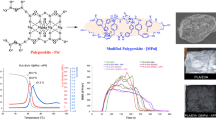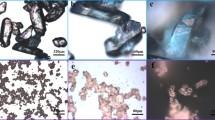Abstract
N,N′-dinitrosopentamethylenetetramine (DNPT), which is a widely used as blowing agent in the rubber industry, tends to be unstable when affected by high temperature and specific impurities. The runaway of DNPT has caused several accidents and led to enormous economic losses in the world. We determined its thermal hazard properties and decomposition paths for process safety. Characteristic parameters of pure and impure (added with water and nitric acid) DNPT were obtained under different heating rates by differential scanning calorimetry experiments. Those parameters were used to calculate the apparent activation energy with the Kissinger method. Thermogravimetry was used to obtain exothermic onset temperature and peak temperature under different heating rates. The apparent activation energy of DNPT decomposition reaction was achieved by model-free kinetics approach. Quantum mechanics model was used to explore the thermal decomposition reaction pathways of DNPT. DFT B3LYP density functional method, and the 6-311++G (D) basis set was selected for molecular simulation by Gaussian 09 software. The single point energy, zero-point energy, thermal energy, thermal enthalpy, and thermal free energy were acquired. The bond dissociation energy (BDE) at different excited states was calculated. By comparing BDE of different excited states, the thermal decomposition reaction pathways can be predicted. The results of experiments and simulations can be applied as safety guidance to deal with DNPT’s loss prevention during transportation, handling, and storage, even emergency response.










Similar content being viewed by others
Abbreviations
- E a :
-
Apparent activation energy, kJ mol−1
- E 0 :
-
Total energy of free radicals or molecules at 0 K, kJ mol−1
- m DNPT :
-
DNPT sample mass, mg
- mH2O:
-
Mass of the added water, mg
- m HNO3 :
-
Mass of the added nitric acid solution, mg
- r 2 :
-
Correlation coefficient, dimensionless
- T :
-
Thermodynamics temperature, °C
- T 0 :
-
Exothermic onset temperature, °C
- T m :
-
Maximum reaction temperature, °C
- T end :
-
End temperature of reaction, °C
- ΔE :
-
Single point energy variation, kJ mol−1
- ΔE′:
-
Zero-point energy variation, kJ mol−1
- ΔH d :
-
Heat of decomposing, J g−1
- ΔZPE :
-
Difference between the total zero point of free radicals or molecules after dissociation and the zero energy before dissociation, kJ mol−1
- α :
-
Conversion degree, dimensionless
- β :
-
Heating rate, °C min−1
References
Chen ZY, Lin HM, Wang L. Study on decomposition temperature of blowing agent. J Zhejiang Inst Sci Technol. 2000;04:7–11.
Zhou Y. Study on activation mechanism of merging using blowing agent and its application in natural rubber foaming. Shanghai: Shanghai Jiao Tong University; 2011.
Thomson BJ. International co-operation in hazardous materials accident prevention. J Loss Prev Process Ind. 1999;12(3):217–25.
Li D. Hangzhou Haihong chemical deflagration event has been in the past year, but the survey report was questioned. Young Times. 2009. http://news.sohu.com/20091121/n268363907.shtml. Accessed 21 Nov 2009.
Zhao RW. Cause analysis of “9.2” hazardous chemicals deflagration accident in Shandong, Linyi. Government network of China. http://finance.sina.com.cn/roll/20090910/18483051578.shtml. Accessed 10 Sept 2009.
Accident investigation team of “3.26”. Taizhou Renhe Chemical Technology Co., Ltd. “3. 26” general deflagration accident investigation report. Safety Supervision Bureau Official Website of Taizhou. http://blog.sina.com.cn/s/blog_724b4a770101ilt4.html. Accessed 20 Jan 2014.
Radhakrishnan S, Talawar MB, Venugopalan S, Narasimhan VL. Synthesis, characterization and thermolysis studies on 3, 7-dinitro-1, 3, 5, 7-tetraazabicyclo [3, 3, 1] nonane (DPT): a key precursor in the synthesis of most powerful benchmark energetic materials (RDX/HMX) of today. J Hazard Mater. 2008;152(3):1317–24.
Cooney AP, Crampton MR, Scranage JK, Scranage John K. Kinetic studies of the pH dependence of the decomposition of 3, 7-dinitro-1, 3, 5, 7-tetra-azabicyclo [3.3.1] nonane (DPT) and related compounds. J Chem Soc Perk Trans. 1989;2(1):77–81.
Liu WJ, Xu ZB, Cui KJ, Xue M. The nitrolysis mechanism of 3, 7-dinitro-1, 3, 5, 7-tetra-azabicyclo [3.3.1] nonane. Propellants Explos Pyrotech. 2015;40(5):645–51.
Peng ZL, Zhang YX. Discussion on factors affecting thermal decomposition of foaming agent H. CN Rub Indus. 1995;06:358–62.
Peng ZL, Wang J, Zhang XF, Zhang YX. Study on decomposition characteristics of foaming agent H in EPDM composites. CN Rub Indus. 2000;47(8):456–9.
Vágenknecht J, Zeman S. Some characteristics of 3,7-dinitro-, 3,7-dinitroso- and dinitrate compounds derived from 1,3,5,7-tetraazabicyclo [3.3.1] nonane. J Hazard Mater. 2005;119(1–3):1–12.
Zeman S, Shu Y, Riedl Z, Vágenknecht J. Thermal reactivity of some nitro- and nitroso-compounds derived from 1,3,5,7-tetraazabicyclo [3.3.1] nonane at contamination by ammonium nitrate. J Hazard Mater. 2005;121(1–3):11–21.
Zhou Y, Peng ZL, Jiang SQ. Activation mechanism of foaming agent H and its effect on foaming of Natural rubber. CN Rub Indus. 2012;59(7):408–14.
Zheng CC, Zhang TZ, Cui ZJ, Han BK, Feng SH. Effect of assistant foaming agent BK and foaming agent H on the foaming properties of NBR/PVC. Spec Purp Rub Prod. 2014;05:30–5.
Berlin AA, Shutov FA. Khymiya i tekhnologiya gazonapolnenykh vysokopolymerov (Chemistry and Technology of Foamed High Polymers). Izdat. 1980.
Zeman S, Dimun M. Nitrosation cleavage of hexamethylenetetramine in slightly acid media from the aspect of the thermochemistry of the nitrosation agent formation. Thermochim Acta. 1981;51(23):325–34.
Zhang MY. Effects of temperature on foaming agent H of emulsified explosive. In: China civil explosives. Proceedings of CCEIC 6. vol 5; 2004. p. 133–137.
Tall A, Zeman S. Determination of heats of decomposition of some 1, 3, 5, 7-tetraazacyclooctane and 1, 3, 5-triazacyclohexane derivatives using differential scanning calorimetry. J Therm Anal Calorim. 1977;12(1):75–81.
Stoessel F. Thermal safety of chemical processes. Weinheim: Wiley-VCH; 2008.
Lv JY. Study on thermal explosion risk of organic peroxides. Nanjing: Nanjing University of Science and Technology; 2015.
Song XS, Yu CR, Linghu RF, Yang XD. Study on the relationship between the dissociation energy of molecular bond and the impact sensitivity of polynitrobenzene. J Atom Mol Phys. 2008;06:1357–61.
Wang ZL. Foaming agent and curing system for sponge rubber. Wor Rub Indus. 2008;35(09):7–15.
Acknowledgements
The authors gratefully acknowledge the financial support provided by the National Natural Science Foundation of China (Grant No. 5100-6122) and the National Key Research and Development Program of China (Grant No. 2016-YFC080-1500).
Author information
Authors and Affiliations
Corresponding author
Rights and permissions
About this article
Cite this article
Liu, Y., Wang, Y., Shu, CM. et al. Molecular simulation and experimental study on thermal decomposition of N,N′-dinitrosopentamethylenetetramine. J Therm Anal Calorim 133, 673–682 (2018). https://doi.org/10.1007/s10973-018-7178-y
Received:
Accepted:
Published:
Issue Date:
DOI: https://doi.org/10.1007/s10973-018-7178-y




